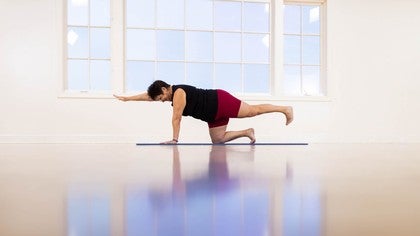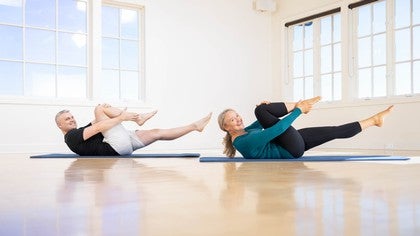Description
About This Video
Transcript
Read Full Transcript
In this tutorial, we're going to look at the position of bird dog. We also call that opposite arm and leg reach. And we do this exercise in several places in the Pilates repertoire. So let's just review bird dog. So I'm in the hands and knees position.
Arms are under my shoulders, knees are relatively under my hips. And I'm going to look at my thumbs and that's where my head is going to go. So in this exercise here, right, we wanna tone the abdomen. We're not doing cat cow, right? We're not doing rounding or flexing at this point.
So the regular bird dog is one leg out, one arm out. Now, you'll notice here that they're both starting on the ground. So I'm just going to lift them both up a smidge, and then another smidge, and then another smidge. So oftentimes in this exercise, we wanna lift so high that the back wants to go into extension. And we want to minimize the extension in the back and maximize the lengthening through the spine and the extremities.
So I'm gonna do it again on each side. I'm gonna curl my toes under because it gives me a place to reach. So this is nothing new here. We understand this opposite arm and leg reach. So what I want to explore here with you for just a second is what happens when you try to do this exercise and you end up sagging into extension.
So what we're going to do is we're actually gonna take extension out of the spine by flexing it. So the first part of this exercise is I'm going to flex my trunk, which includes my neck, okay, and bring my body down a little bit. There's no rule except for now I'm in a flex position. Then I'm gonna take each arm and take turns lifting the arm and not my neck. Because I've allowed my neck to lengthen, drawing my throat back, drawing my ribs back, so I maintain a flexion force in the front of my body, and then I allow my arm to lift from my shoulder blade and my upper back.
So now I feel this predominantly in the posterior part of my arm and the posterior part of my back. So that would be the arm component. So now the leg component says I'm going to bring one knee in and I'm gonna sneak that other leg back, going to come to my forearms, nodding my head as I pull my throat back, and then I'm going to reach my long leg here and I'm going to lift it up and down. And as I lift this up and down, I'm gonna resist the urge to lift my head up. I wanna maximize my leg and my thigh and my butt and minimize extension in the back so that it really turns on and fires those posterior thigh and bum muscles.
So here's what it will look like if we did opposite arm and leg reach. So I'm going to take one knee forward, and again, the knee forward is actually giving me a posterior tilt in my pelvis. And so now, I can take one arm out in front, my head is looking down, my opposite arm is pressing down to get into the shoulder blade engagement. And then as I do this exercise, I'm going to lift my arm and my leg. This is a lot harder than it looks because I'm not allowing any extension in my spine.
So sometimes when we do that bird dog exercise, we fight with the head position or we fight with the neck position or the low back position. So working this bird dog in a little bit of a flexed posture will allow you to feel the action of your arms and legs a little bit better. Thanks for joining me.
Tips for Teachers: Keep It Fresh! Exercise Tutorials
Comments
You need to be a subscriber to post a comment.
Please Log In or Create an Account to start your free trial.


















